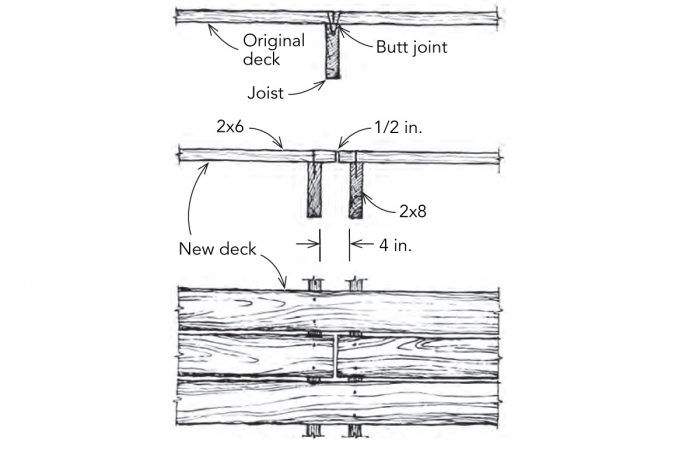Double Decking
Building a deck with doubled-up joists means the planks can stretch out, there are no ends over a joist, and there is no doubling up on nailing.

To celebrate FHB’s 40th anniversary, I’ve chosen my favorite Tips & Techniques from the first year of the magazine to feature throughout the year. A lot of the time these tips still work and don’t cost much. Here’s one of them…
Building a deck with doubled-up joists seems like a measure of extra work. But in this tip from Fine Homebuilding issue #5, it meant that the planks could stretch out, there were no ends over a joist, and there was no doubling up on nailing. The lumber prices might be different today, but the tip stands as is.
—Charles Miller
When our house was built in 1958, the plan included large decks on two sides. They were built conventionally: 2×8 joists covered with 2×6 planks set on 6-in. centers. By 1980 I had to replace the decking, primarily because of rot that started wherever two 2x6s butted each other over a joist.
My design involved doubling up the joists at each station, as shown in the drawing. This simple change accomplishes the following: no tight butts in planking, no butts over joists, no split 2x6s from nailing them at their ends, and the entire structure can now “breathe.”
The deck has a width of 15 2x6s. With careful layout using lengths up to 20 ft., I have no more than four joints at any station, minimizing waste. I used pressure-treated southern yellow pine. All the lumber cost about $1000, and only $64 was added by doubling up on the 2x8s.
—James B. French, Portsmouth, R.I.
Edited and Illustrated by Charles Miller
Published in Fine Homebuilding #302
Fine Homebuilding Recommended Products
Fine Homebuilding receives a commission for items purchased through links on this site, including Amazon Associates and other affiliate advertising programs.

Jigsaw

Drill Driver/Impact Driver

Angel Guard Deck Demon





























